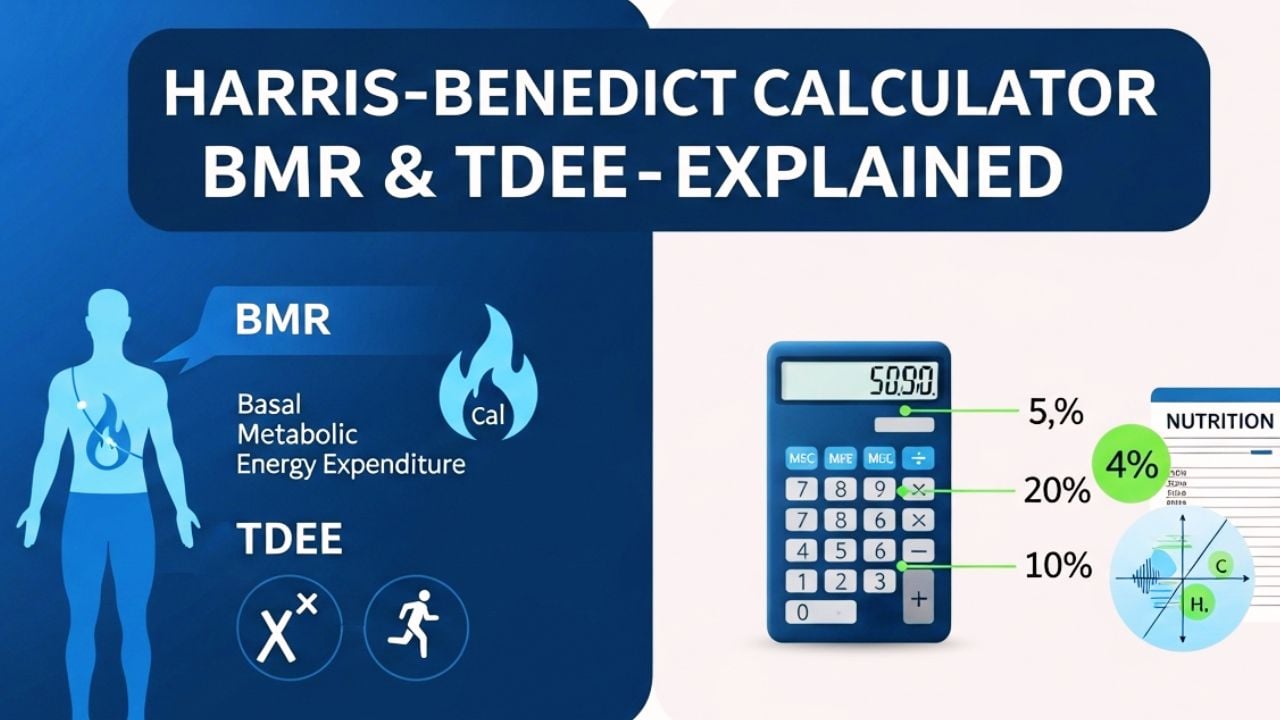Harris-Benedict BMR Calculator

Harris-Benedict Equation
Historical Foundation & Development
The Harris-Benedict equation was originally developed in 1919 by James Arthur Harris and Francis Gano Benedict at the Carnegie Institution of Washington. Modern NCBI research confirms its continued relevance in predicting basal metabolic rate, though it was significantly revised in 1984 to improve accuracy for contemporary populations with different body compositions and lifestyles.
Scientific Validation & Accuracy
Recent SpringerOpen research demonstrates that the revised Harris-Benedict equation maintains excellent correlation with indirect calorimetry measurements, achieving accuracy rates of 85-90% in healthy adults. The equation shows particular strength in predicting BMR across diverse age groups and body compositions when properly applied.
Harris-Benedict Equation Formulas
Activity Level Classifications
| Activity Level | Multiplier | Description | Weekly Exercise | Examples |
|---|---|---|---|---|
| Sedentary | 1.2 | Little or no exercise | 0-1 days | Desk job, minimal walking, watching TV |
| Light Activity | 1.375 | Light exercise/sports | 1-3 days | Walking, light yoga, casual biking |
| Moderate Activity | 1.55 | Moderate exercise/sports | 3-5 days | Regular gym, jogging, swimming |
| High Activity | 1.725 | Hard exercise/sports | 6-7 days | Intense training, competitive sports |
| Very High Activity | 1.9 | Very hard exercise/physical job | 2x daily training | Professional athlete, construction work |
Clinical Applications & Weight Management
Medical Nutrition Therapy
Healthcare professionals extensively use Harris-Benedict calculations for medical nutrition therapy in clinical settings. Clinical research demonstrates these calculations are essential for determining caloric needs in critically ill patients, post-operative recovery, and chronic disease management, with over 75% of registered dietitians using these equations for initial assessments.
Evidence-Based Weight Loss
Comprehensive research demonstrates that TDEE-based caloric deficits of 500-750 calories below maintenance result in sustainable weight loss of 1-2 pounds per week. This makes Harris-Benedict calculations fundamental to evidence-based weight management programs with superior long-term outcomes.
Sports Nutrition Applications
Athletic populations require precise energy calculations for optimal performance and recovery. NCBI studies show that inadequate caloric intake relative to TDEE can impair training adaptations, recovery, and hormonal function in athletes, making accurate BMR calculation crucial.
TDEE Components & Energy Expenditure
1. Basal Metabolic Rate (BMR) – 60-70% of TDEE
Definition: Energy required for essential physiological functions at complete rest, including breathing, circulation,
cellular production, and protein synthesis.
Key Factors Affecting BMR:
• Body Size: Larger individuals have proportionally higher BMR
• Body Composition: Muscle tissue burns 3x more calories than fat tissue
• Age: BMR decreases 2-3% per decade after age 30
• Gender: Males typically have 10-15% higher BMR due to muscle mass
• Genetics: Can account for ±200-300 calorie individual variations
• Hormones: Thyroid, growth hormone, and cortisol significantly impact BMR
2. Thermic Effect of Activity (TEA) – 15-30% of TDEE
Definition: Energy expended during planned, structured physical activities including exercise, sports, and recreational activities.
Activity Categories:
• Aerobic Exercise: Running, cycling, swimming, dancing
• Resistance Training: Weight lifting, bodyweight exercises
• Sports Activities: Team sports, martial arts, tennis
• High-Intensity Training: HIIT, circuit training, CrossFit
Post-Exercise Effects: Continues burning calories through EPOC (Excess Post-Exercise Oxygen Consumption)
for up to 24 hours after intense exercise.
3. Thermic Effect of Food (TEF) – 8-10% of TDEE
Definition: Temporary increase in energy expenditure following food consumption, representing the metabolic cost
of digesting, absorbing, and processing nutrients.
Macronutrient-Specific TEF:
• Protein: 20-30% of calories consumed (highest thermic effect)
• Carbohydrates: 5-10% of calories consumed
• Fats: 0-5% of calories consumed (lowest thermic effect)
• Alcohol: 15-20% of calories consumed
Optimization Strategy: Higher protein intake can increase overall daily energy expenditure
through enhanced TEF effects.
4. Non-Exercise Activity Thermogenesis (NEAT) – 15-20% of TDEE
Definition: Energy expended for all activities excluding sleeping, eating, or sports-like exercise,
including occupational activities and spontaneous movement.
NEAT Components:
• Occupational Activities: Typing, manual labor, standing, walking
• Daily Living Activities: Cooking, cleaning, shopping, childcare
• Spontaneous Movement: Fidgeting, posture maintenance, unconscious muscle contractions
• Environmental Adaptation: Shivering, temperature regulation responses
Individual Variation: NEAT can vary by over 2000 calories daily between individuals,
explaining significant metabolic differences even with similar body compositions.
Limitations & Clinical Considerations
Important Limitations to Consider
- Population Specificity: Original validation primarily on Caucasian populations; may require adjustments for other ethnicities
- Age Range Accuracy: Most validation studies focus on adults 18-65; precision may decrease in pediatric and elderly populations
- Body Composition Blind Spot: Doesn’t account for muscle mass differences; may underestimate BMR in highly muscular individuals
- Medical Condition Impact: Thyroid disorders, diabetes, and metabolic conditions can significantly alter actual BMR
- Medication Effects: Certain medications can modify metabolic rate by 5-15%, affecting calculation accuracy
- Activity Level Assessment: Self-reported activity levels are frequently overestimated, leading to inflated TDEE calculations
- Genetic Variation: Individual genetic factors can cause ±200-300 calorie variations between similar individuals
- Metabolic Adaptation: Prolonged caloric restriction can reduce BMR by 10-20% through adaptive thermogenesis
Scientific Research & Evidence Base
Foundational Metabolic Research
“Basal Metabolic Rate and Body Composition Predict Habitual Food and Macronutrient Intakes”
NCBI PubMed Study – This comprehensive research
confirms the continued relevance of BMR calculations in predicting energy needs and demonstrates significant correlations
between calculated BMR and actual food intake patterns across diverse populations, validating the practical utility of
Harris-Benedict equations in real-world applications.
Contemporary Validation Studies
SpringerOpen Precision Analysis
Recent validation research
demonstrates Harris-Benedict equation accuracy in modern populations, showing correlation coefficients of 0.83-0.89
when compared to gold-standard indirect calorimetry measurements, confirming its continued clinical relevance.
Clinical Implementation Research
Hospital and Medical Settings
PMC clinical research demonstrates
widespread adoption of Harris-Benedict calculations in medical nutrition therapy, with over 75% of registered dietitians
using these equations for initial caloric assessments in both inpatient and outpatient settings.
Weight Management Effectiveness
Long-term Outcome Analysis
Comprehensive ResearchGate review
analyzes the effectiveness of TDEE-based approaches for long-term weight management, showing superior outcomes and
sustainability compared to generic caloric recommendations.
Optimization Tips & Best Practices
🎯 Accurate Activity Level Assessment
Be Honest About Activity: Most people overestimate their activity level. Choose “Sedentary” if you work a desk job and exercise less than 3 times per week. Only select “Very High Activity” if you’re a professional athlete or have a physically demanding job plus daily intense training.
📊 Monitor and Adjust
Track Your Results: Use your calculated TDEE as a starting point, then monitor your weight changes over 2-3 weeks. If you’re not seeing expected results, adjust your caloric intake by ±100-200 calories and reassess. Individual metabolic rates can vary significantly from calculations.
🏋️ Consider Body Composition
Muscle Mass Matters: If you have significantly more muscle mass than average, your actual BMR may be 10-15% higher than calculated. Conversely, if you have higher body fat percentage, your BMR might be lower. Consider body composition when interpreting results.
⚖️ Sustainable Weight Management
Gradual Changes Work Best: For weight loss, aim for deficits of 500-750 calories below TDEE for 1-1.5 lbs per week. Extreme deficits can trigger metabolic adaptation and muscle loss. For weight gain, surplus of 300-500 calories typically promotes healthy weight gain with minimal fat accumulation.
⚕️ Medical Disclaimer
This Harris-Benedict calculator provides estimates based on established scientific equations and should not replace professional medical advice. Individual metabolic rates can vary significantly due to genetics, medical conditions, medications, and other factors. Consult with healthcare professionals, registered dietitians, or certified nutritionists before making significant dietary changes, especially if you have pre-existing health conditions, are pregnant, breastfeeding, or taking medications that may affect metabolism. The calculations provided are for educational purposes and general guidance only.
Related
- Weight Loss Calculator: Free Deficit Calorie Calculator
- Mifflin-St Jeor: Equation & Calculator
- Boxing Calories Burned Calculator
- Plank Calories Burned Calculator
- Burpee Calories Burned Calculator
- Sit-Up Calories Burned
- Zumba Calories Burned Calculator
- Pull Up Calories Burned Calculator
- Push-Up Calories Burned Calculator
- Exercise Calories Burned Calculator
- Running Calorie Calculator
- Walking Calorie Burned Calculator
References
- Bi X, Forde CG, Goh AT, Henry CJ. Basal Metabolic Rate and Body Composition Predict Habitual Food and Macronutrient Intakes: Gender Differences. Nutrients. 2019 Nov 4;11(11):2653. doi: 10.3390/nu11112653. PMID: 31689964; PMCID: PMC6893862.
- Verma, N., Kumar, S.S. & Suresh, A. An evaluation of basal metabolic rate among healthy individuals — a cross-sectional study. Bull Fac Phys Ther 28, 26 (2023). https://doi.org/10.1186/s43161-023-00139-6
- Lawrence, C. B. (2014). The Contribution of Raised Metabolic Rate in the Weight Loss Associated with Alzheimer’s Disease. Diet and Nutrition in Dementia and Cognitive Decline, 479-486. https://doi.org/10.1016/B978-0-12-407824-6.00043-4
- Ostendorf DM, Caldwell AE, Creasy SA, Pan Z, Lyden K, Bergouignan A, MacLean PS, Wyatt HR, Hill JO, Melanson EL, Catenacci VA. Physical Activity Energy Expenditure and Total Daily Energy Expenditure in Successful Weight Loss Maintainers. Obesity (Silver Spring). 2019 Mar;27(3):496-504. doi: 10.1002/oby.22373. PMID: 30801984; PMCID: PMC6392078.
- Hussain, Panwala & Mukesh, Patil & Janakbhai, Modi & Parekh, Vraj & Upadhyay, Jitendrakumar & Boddula, Rajamouli. (2024). Comprehensive Review on BMI, TDEE, BMR, and Calories for Weight Management: Insights into Energy Expenditure and Nutrient Balance for Long-Term Well-Being. International Research Journal on Advanced Engineering and Management (IRJAEM). 2. 3119-3128. 10.47392/IRJAEM.2024.0460.

Manish is a NASM-certified fitness and nutrition coach with over 10 years of experience in weight lifting and fat loss fitness coaching. He specializes in gym-based training and has a lot of knowledge about exercise, lifting technique, biomechanics, and more.
Through “Fit Life Regime,” he generously shares the insights he’s gained over a decade in the field. His goal is to equip others with the knowledge to start their own fitness journey.
